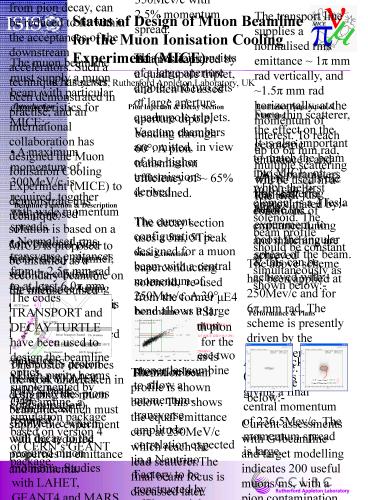ESS Rings Beam Loss Collection - PowerPoint PPT Presentation
Title:
ESS Rings Beam Loss Collection
Description:
Status of Design of Muon Beamline for the Muon Ionisation Cooling Experiment (MICE) ... target is 1mm thick and 10mm long, is dipped 2-5mm into the halo of the ISIS ... – PowerPoint PPT presentation
Number of Views:25
Avg rating:3.0/5.0
Title: ESS Rings Beam Loss Collection
1
Status of Design of Muon Beamline for the Muon
Ionisation Cooling Experiment (MICE)
K. Tilley, ISIS, Rutherford Appleton Laboratory,
UK
Introduction
Emittance Preparation Matching
Pion Injection Decay Section
The first two sections of the beamline are
designed for pion momenta of 350Mev/c with 2.5
momentum spread. Beam is captured by a
quadrupole triplet, and then focussed through a
large aperture dipole, bending through 60. A
pion transmission efficiency of 65 is
obtained. The decay section uses a 5m, 5Tpeak
field, superconducting solenoid, re-used from
the former µE4 beamline at PSI. The full-width
pion beam profile for the first 2 sections is
shown below-
A Neutrino Factory based on a muon storage ring,
is the ultimate tool for studying neutrino
oscillations. Ionisation cooling forms one of the
key stages in the complex, whereby the large
emittances of the muon beam, produced from pion
decay, can be reduced to fit within the
acceptances of the downstream accelerators. Such
a technique has never been demonstrated in
practise, and an international collaboration has
designed the Muon Ionisation Cooling Experiment
(MICE) to demonstrate this technique. MICE is
proposed to be installed as a secondary beamline
on the intense pulsed proton synchrotron at the
ISIS facility, at Rutherford Appleton Laboratory
(RAL). This poster describes the work undertaken
in designing the muon beamline, which must supply
the experiment with the required properties in
emittance and momenta.
The transport line supplies a normalised rms
emittance 1p mm rad vertically, and 1.5p mm
rad horizontally, at the momentum of interest.
To reach up to 6p mm rad, multiple scattering
will be used in a lead disk just before the
experiment, to boost the angular spread of the
beam.
For a thin scatterer, the effect on the geometric
emittance e and Twiss parameters (a,ß) can be
approximated by-
Beamline Function Description
It is also important to match the beam into MICE,
of which the first element is a 4Tesla solenoid.
The beam profile should be constant this can be
achieved with-
- The muon beamline must supply a muon beam with
particular characteristics for MICE- - A maximum momentum of 300MeV/c is required,
together with wide momentum spreads. - Normalised rms transverse emitances from 2.5p
mm rad to at least 6.0p mm rad and possibly
beyond. - High rates must be supplied for good statistics
- High purity beams (lt10 basic contamination)
required.
The two conditions of emittance tuning and
matching are achieved simultaneously as shown
below-
Muon Extraction
This section consists of a large aperture dipole,
and two sets of large aperture quadrupole
triplets. Vacuum chambers are omitted, in view of
the higher transmissions derived. The current
configuration is designed for a muon beam with a
central momentum of 250Mev/c. A 30 bend allows a
large muon momentum spread to be achieved. These
two properties combine to allow a
momentum-transverse amplitude correlation
expected in a Neutrino Factory to be constructed
by offline particle selection
The proposed solution is based on a conventional
pion-muon decay channel, with the capability for
emittance tuning matching. The 5 main sections
are labelled below-
Performance Plans
The above scheme has been applied at 250Mev/c and
for 6p mm rad. The scheme is presently driven by
the smaller vertical emittance. Some results are
shown below-
p 200 (ref) 30(A.v.p) 6.5 (MICE
LH2)13.5 (Pb) 250MeV/c
The muon beam profile is shown below. This shows
the equal emittance core at 250MeV/c which reach
the lead scatterer.The final beam focus is
discussed later.
The codes TRANSPORT and DECAY TURTLE have been
used to design the beamline optics, supplemented
by G4beamline, a simulation package based on
version 4 of CERNs GEANT package.
Target
A lead thickness of 0.8cm was used, giving a
final central momentum of 236.5Mev/c. The
momentum spread is large.
The titanium target is 1mm thick and 10mm long,
is dipped 2-5mm into the halo of the ISIS proton
beam at 800MeV. This provides pions with at least
350MeV/c which will decay to the required muon
momenta. Studies with LAHET, GEANT4 and MARS have
been undertaken to estimate particle production.
Current assessments with G4beamline and target
modelling indicates 200 useful muons/ms, with a
pion contamination approaching 0.1. Modelling
and simulation work will continue and with
suitable funding, beam is anticipated at the end
of the proposed ISIS 2005/06 long shutdown.

